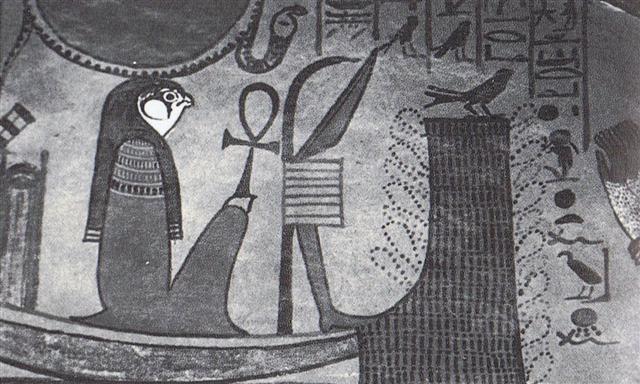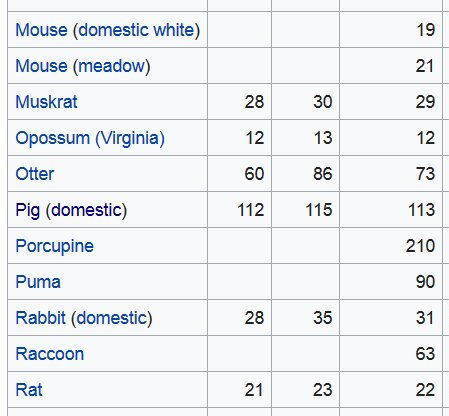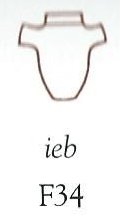There surely was an ancient system, still remembered by a few: ... 'From now on', said Father Sun, grieving over Phaeton, his fallen child, 'you shall be Mink'. What meaning can this have for us? For such an understanding between men and men, and other living creatures too, we would need the kind of help King Arthur had at hand: 'Gwryr Interpreter of Tongues, it is meet that thou escort us on this quest. All tongues hast thou, and then canst speak all languages of men, with some of the birds and beasts.' This ability was also attributed to Merlin and Gwyon, those masters of cosmological wisdom whose names resound through the legends of the Middle Ages. In general, all fabulous communication was conceived as having such a range, not merely the Aesopian fable with is flat, all-too-wordly wisdom ... ... Using our imagination we can guess what it meant for Phaeton - who had plunged down into the water of the Sea - to become Mink. He had to swim:
... The picture above shows the American mink, but presumably the myth refers to the Sea mink (Neovison macrodon) which was hunted down to extinction around 1860 (before he had been scientifically described). His fur was highly prized, but the animal himself obviously had no value ... None of the 12 Chinese years was a Mink:
Neither was there a Chinese month named Mink. But we can identify 10 animals who were named both among the 12 and among the 28.
I have redmarked the Porcupine because the function of this animal can be decoded. First of all it marks the northern spring equinox, the most important cardinal point of the year - viz. at heliacal Algenib in the Pegasus Square according to the Chinese:
All the spines (tara) of the pair up in the Tree in the picture above ought to imply the same thing as the 'heart of every circuit': ... In the inscriptions of Dendera, published by Dümichen, the goddess Hathor is called 'lady of every joy'. For once, Dümichen adds: Literally ... 'the lady of every heart circuit'. This is not to say that the Egyptians had discovered the circulation of the blood. But the determinative sign for 'heart' often figures as the plumb bob at the end of a plumb line coming from a well-known astronomical or surveying device, the merkhet. Evidently, 'heart' is something very specific, as it were the 'center of gravity' ... See Aeg.Wb. 2, pp. 55f. for sign of the heart (ib) as expressing generally 'the middle, the center'. And this may lead in quite another direction. The Arabs preserved a name for Canopus - besides calling the star Kalb at-tai-man ('heart of the south') ... Suhail el-wezn, 'Canopus Ponderosus', the heavy-weighing Canopus, a name promptly declared meaningless by the experts, but which could well have belonged to an archaic system in which Canopus was the weight at the end of the plumb line, as befitted its important position as a heavy star at the South Pole of the 'waters below'. Here is a chain of inferences which might or might not be valid, but it is allowable to test it, and no inference at all would come from the 'lady of every joy'. The line seems to state that Hathor (= Hat Hor, 'House of Horus') 'rules' the revolution of a specific celestial body - whether or not Canopus is alluded to - or, if we can trust the translation 'every', the revolution of all celestial bodies. As concerns the identity of the ruling lady, the greater possibility speaks for Sirius, but Venus cannot be excluded; in Mexico, too, Venus is called 'heart of the earth'. The reader is invited to imagine for himself what many thousands of such pseudo-primitive or poetic interpretations must lead to: a disfigured interpretation of Egyptian intellectual life ... Tara. 1. Thorn: tara miro. 2. Spur: tara moa. 3. Corner; te tara o te hare, corner of house; tara o te ahu, corner of ahu. Vanaga. (1. Dollar; moni tara, id.) 2. Thorn, spike, horn; taratara, prickly, rough, full of rocks. P Pau.: taratara, a ray, a beam; tare, a spine, a thorn. Mgv.: tara, spine, thorn, horn, crest, fishbone. Mq.: taá, spine, needle, thorn, sharp point, dart, harpoon; taa, the corner of a house, angle. Ta.: tara, spine, horn, spur, the corner of a house, angle. Sa.: tala, the round end of a house. Ma.: tara, the side wall of a house. 3. To announce, to proclaim, to promulgate, to call, to slander; tatara, to make a genealogy. P Pau.: fakatara, to enjoin. Mq.: taá, to cry, to call. 4. Mgv.: tara, a species of banana. Mq.: taa, a plant, a bird. Ma.: tara, a bird. 5. Ta.: tara, enchantment. Ma.: tara, an incantation. 6. Ta.: tara, to untie. Sa.: tala, id. Ha.: kala, id. Churchill. ... On Easter Island it was the sooty tern, the sea swallow, manu tara, who arrived on wings with spring ... Swallows are swallowing insects (the souls of the unborn) and their return in spring should mean the return of the spirits to Mother Nature ...
The Porcupine ('pig with spines') followed after the Pig (eaten at the winter solstice). And then we can arrive at a kind of 'proof' of a correct interpretation by looking at the gestation period noted for the Porcupine. Because 115 (Pig) + 210 (Porcupine) = 325 → March 25 (the day for the Julian spring equinox).
This comparably long gestation period of the Porcupines (210) surely could be perceived as representing half the set of the 42(0) Egyptian judges of the dead:
... They tightly swathed the broken body in linen bandages, and when they performed over it the rites that thereafter were to be continued in Egypt in the ceremonial burial of kings, Isis fanned the corpse with her wings and Osiris revived, to become the ruler of the dead. He now sits majestically in the underworld, in the Hall of the Two Truths, assisted by forty-two assessors, one from each of the principal districts of Egypt; and there he judges the souls of the dead ...
... I think the weighing of the heart down in the Underworld is a misunderstanding. The 'Heart' is balanced against a 'Feather'. The light bird feathers symbolize air and the heavy heart symbolizes a bucket of water ...
... the determinative sign for 'heart' often figures as the plumb bob at the end of a plumb line coming from a well-known astronomical or surveying device, the merkhet ...
The 42 assessors down in the Underworld are sitting in two lines at the top of the picture, 21 in each line. Each such assessor could have represented 10 days. ... according to the legend Sabazius was torn by the Titans into seven pieces. Seven was Jehovah's mystical number; so was also 42, the number of letters in his enlarged Name, and according to Cretan tradition, the number of pieces into which the Titans tore the bull-god Zagreus ... 10 * 36 (= 360 days, viz. the length of the well-ordered Egyptian year) + 10 * 42 (assessors down below) = 780.
But I have not searched for information regarding the gestation period of the Mink. |
||||||||||||||||||||||||||||||||||||||||||||||||||||||||||||||||||||||||||||||||||||||||||||||||||||||










